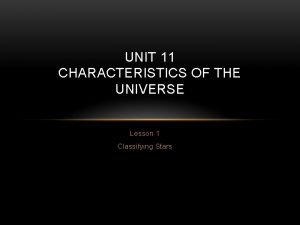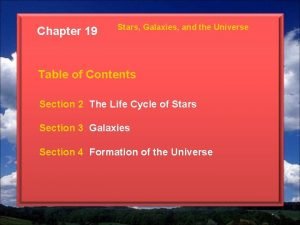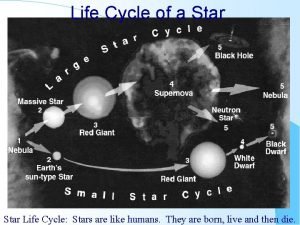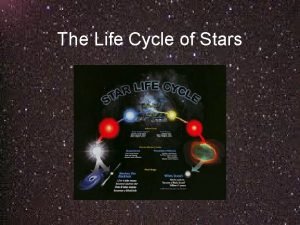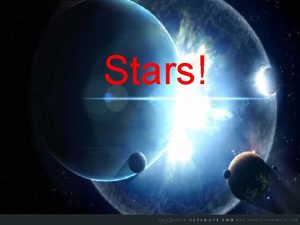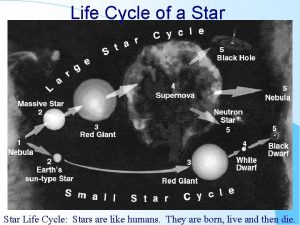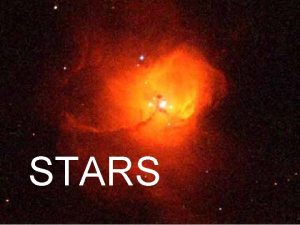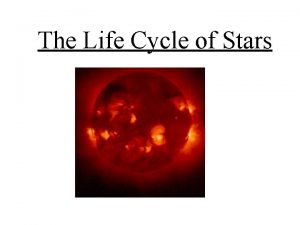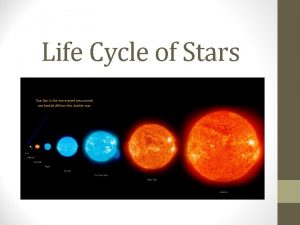The Life Cycle of Stars A Note Taking





























- Slides: 29

The Life Cycle of Stars A Note Taking Experience.

Cycle for all stars • Stage One- A star is born in a vast, dense cloud of gas, mostly hydrogen and helium, and dust called a Nebula.

• Stage Two - As a nebula collapses, gravity pulls the hydrogen gas in the nebula together and it begins to spin; as the gas spins faster, it heats up and is known as a Protostar.

• Once a protostar forms and the temperature reaches 15, 000 degrees Celsius, a star turn hydrogen into helium within its Core by Nuclear Fusion.

• Stage Three - The cloud begins to glow brightly and at this temperature it contracts and becomes stable as a Main Sequence Star/Yellow Star. Our Sun is in this stage right now.

• As the Main Sequence Star glows, hydrogen in the core is converted into helium by Nuclear Fusion. http: //www. waowen. screaming. net/revision/universe/msstar. htm. • http: //www. waowen. screaming. net/revision/universe/redgiant. htm

Hydrostatic Equilibrium • In a steadily burning star on the main sequence, the outward pressure of hot gas exactly balances the inward pull of gravity. This is true at every point within the star, guaranteeing its stability.

• Stage Four - When the hydrogen supply in the core begins to run out, the core becomes unstable and contracts; the outer shell of the star which is still mostly hydrogen, starts to expand. As it expands, it cools and glows red; it has now reached the Red Giant Phase.



Mass of Star Determines Fate • All stars evolve the same way up to the Red Giant Phase. The amount of mass a star has determines which of the following life cycle paths it will take after the Red Giant Phase. • Small Stars • Massive Stars

Fate of Small Stars • Stage Five- Helium atoms in the core fuse to form carbon atoms; the hydrogen gas in the outer shell is blown away to form a ring around the core called a Planetary Nebula

• Stage Six- Gravity causes the last of the star’s matter to collapse inward and compact into an extremely dense White Dwarf core that glows with a white hot light.

• Stage Seven - Once all of a white dwarf’s energy is gone, it no longer emits light, reaching the Black Dwarf phase in which it will forever remain. A completely dead star that is dark and cold. • This is the end of a small star’s life.

Fate of a Massive Star • In the next million years, a series of nuclear reactions occur forming a carbon atoms from the fusion of helium atoms; gravity continues to pull carbon atoms together as the temperature increases forming oxygen, nitrogen, and eventually iron. GETTING HEAVY!

• Stage Five - Fusion stops and the iron atoms start to absorb energy; this energy is eventually release in a powerful explosion called a Supernova; a supernova can light up the sky for weeks.

• Stage Six a - The core of a massive star that is 1. 5 to 4 times as massive as our Sun ends up as a Neutron Star after the supernova; neutron stars spin rapidly giving off radio waves emitted in pulses, these neutron stars are called Pulsars.

• Stage Six b - The core of a massive star that has 8 or more times the mass of our Sun remains massive; no nuclear fusion takes place to support the core, so it is swallowed by its own gravity becoming a Black Hole.








HR Diagram



 Difference between note making and note taking
Difference between note making and note taking Signal word
Signal word Difference between note making and note taking
Difference between note making and note taking Relevance of note making
Relevance of note making The rwenzori mountains mary daniels is a student in england
The rwenzori mountains mary daniels is a student in england Mid mass stars
Mid mass stars Life cycle of a star notes
Life cycle of a star notes Star life cycle simulation
Star life cycle simulation Life cycle of stars graphic organizer
Life cycle of stars graphic organizer Chapter 19 section 2 the life cycle of stars answer key
Chapter 19 section 2 the life cycle of stars answer key Stellar evolution poster
Stellar evolution poster Modified cornell notes
Modified cornell notes Sentence method of note taking
Sentence method of note taking Section 17-3 practice commonly abused drugs
Section 17-3 practice commonly abused drugs What are the 5 r's of note taking
What are the 5 r's of note taking What are the 5 r's of note taking
What are the 5 r's of note taking Note taking process
Note taking process Outline method of note taking
Outline method of note taking Prerequisites of note-taking
Prerequisites of note-taking Mind mapping note taking method
Mind mapping note taking method Tyutyuy
Tyutyuy Cornell note taking method
Cornell note taking method Five phases of focused note taking
Five phases of focused note taking Note taking abbreviations
Note taking abbreviations Cornell note taking strategy
Cornell note taking strategy Cornell note taking strategy
Cornell note taking strategy Sentence method of note taking
Sentence method of note taking Summarizing and note taking strategies
Summarizing and note taking strategies Summarizing and note taking strategies
Summarizing and note taking strategies What is the objective of a note
What is the objective of a note








